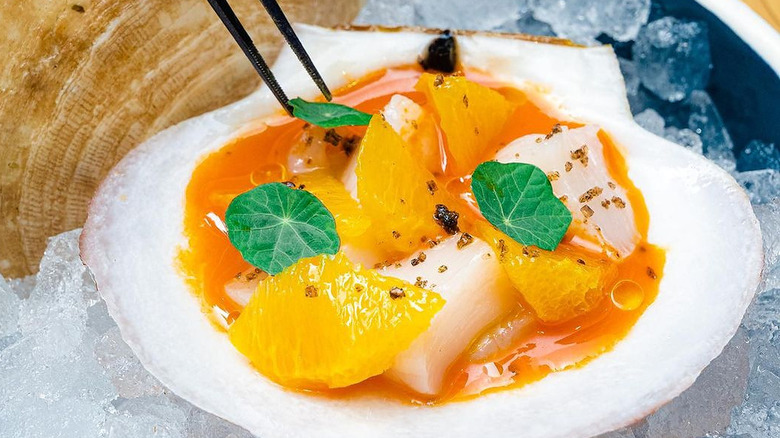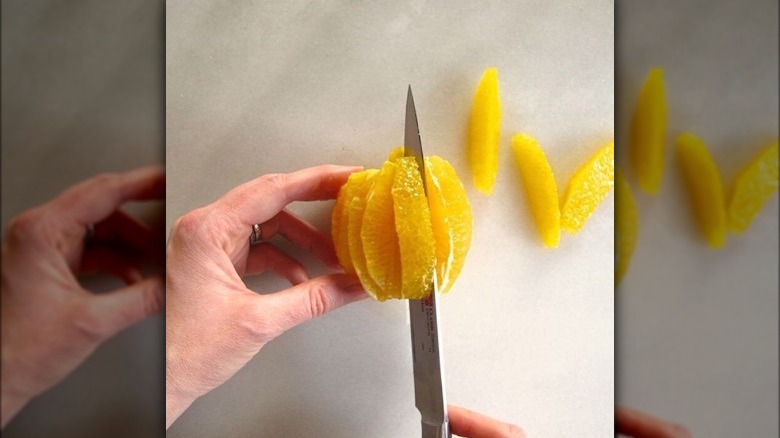How To Cut Citrus Fruit Into Tender, Juicy Supremes
There's nothing wrong with peeling a fresh orange and popping the segments like candy, but if you want to showcase your citrus in a beautiful way, look to citrus supremes.
To make a supreme (soo-PREM), you use a French culinary technique to separate the flesh of the fruit from the membrane and the pith. While this may sound complicated, it is perfectly doable for the home cook. All you need is a cutting board, a knife, and your citrus of choice to create half-moon jewels, perfect for your prettiest salads and desserts.
Select ripe but firm citrus fruits. Older fruits tend to dry out, making them harder to work with. Plus, if the flesh of the fruit is past its prime, it isn't worth going through the effort of cutting supremes. If you're new to this technique, select fruits that are round and uniform, like navel oranges, because the segments will be easier to cut out. You can supreme any citrus variety, but a small fruit like lime or fruit with irregular segments like grapefruit will be more challenging to work with.
The key to gracefully cutting supremes is a really sharp knife. A dull knife makes it challenging to peel the fruit and can tear the delicate segments. Some prefer to start with a chef's knife and use a paring knife for more detailed cuts, but depending on preference, you can use either for the whole process.
Cutting supremes, step-by-step
On the cutting board, place your citrus fruit on its side. Cut off each of the ends and turn the fruit so the flat-sided top or bottom is on the cutting board. The fruit should be stable enough to stand on its own, making it safer to cut. Hold the knife with your dominant hand and the fruit with your non-dominant. Starting at the top, cut off the brightly colored zest and the spongy white pith, following the curve of the fruit, like you are cutting off the skin of a whole pineapple. You should be left with a brightly colored globe with the flesh fully exposed and the thin lines dividing each segment visible.
Now, hold the peeled fruit in your hand over a bowl to catch any juice. Identify the segment you are separating. Cut as close as you can along the thin white membrane on both the left and right of the segment, angling slightly towards the center of the segment as you do. The piece will slide out onto your knife, or you can use your finger to pop it out. Turn the fruit and repeat segment by segment. Oddly shaped segments are more challenging to remove, but use the membrane as a guide. A small paring knife is definitely helpful here.
How to serve citrus supremes
Citrus supremes are definitely a stunning treat. You get to experience the pure delight of juicy fresh fruit, without any bitterness or tough textures that come from the membrane and pith. Because you went through the effort of cutting such pretty supremes, make sure you show them off — but don't forget about the rest of the fruit. Squeeze the last drops of juice out of the segmentless membrane and use it to make a vinaigrette or simple syrup. Use the peels to make marmalade or candy them for a vibrant garnish in any number of dishes.
Scatter grapefruit supremes across the top of a kale salad with beets, walnuts, and goat cheese, and use the juice to make a zingy dressing. You can go a semi-homemade route with a dreamsicle-inspired ice-cream sundae. Top store-bought vanilla ice cream with a spoonful of marmalade and beautiful tangerine supremes. Go decadent with this Meyer lemon and olive oil cake recipe. Use the leftover lemon juice to make the glaze, and top with Meyer lemon supremes and candied zest for an impressive garnish. Any recipe that calls for citrus can be made a little more special when you use citrus supremes.



